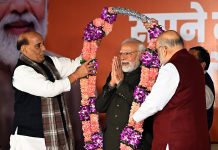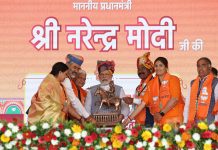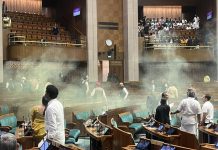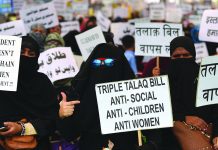The BJP has been able to retain power in Gujarat and form the government in Himachal Pradesh following weeks of intense and sometimes bitter campaigning. Congress put up a credible fight in Prime Minister Narendra Modi’s home turf where nearly half the Union Cabinet had led a high-pitched campaign against the Congress and its newly appointed President Rahul Gandhi. When the results started coming out, it was initially a neck and neck between the two parties in Gujarat, but BJP bounced back with a steady lead. In Himachal Pradesh, where the government has been alternating since 1990 between the Congress and the BJP, the saffron party trounced Congress comfortably and registered a facile win in the election which recorded a 75.28 per cent turnout, the highest-ever in the state, though its chief ministerial candidate Prem Kumar Dhumal and state party chief Satpal Satti lost.
The BJP’s below-expectation performance in Gujarat can have deep significance for India’s economy. Prime Minister Modi had pushed through radical economic reforms such as demonetization and the Goods and Services Tax (GST) despite expected negative impact on people. BJP had set a lofty target of 150 seats in Gujarat. The Congress put up a good fight to what was always a tough battle. In view of tough challenge from Congress and with an eye on the 2019 general election, Modi is not expected to continue with his streak of disruptive reforms. While Modi is likely to shun reforms, expect him to take populist steps and do a lot of social spending — the measures that are seen to win votes.
After being in power for 22 years and faced with plenty of issues on the ground, expecting a BJP sweep was tough. In the end, the PM’s campaign obviously helped. Sure they didn’t sweep, but a win is a win, and to find faults with winners is the doing of sore losers. However, when it comes to an election in the state that reveres the country’s Prime Minister and is bound to have consequences for the next general election, it ought to be dissected and analysed owing to its enormous magnitude.
What was peculiar about this year’s Gujarat assembly election was that the BJP appeared to be the most insecure about its electoral performance in its stronghold since the time Narendra Modi established his hold over the state in 2001, that ultimately led to his elevation to the Prime Minister’s post. This time the BJP won the least number of seats since Modi took over the state’s reins as chief minister and established himself as its tallest leader.
Factors at play
Economic Woes
One factor that the BJP had been most anxious about was the noticeable anger of Gujarat’s predominant community, staunch supporters of the party, for the disruptions in trade and economy caused by demonetisation and shaky implementation of GST. The BJP left no stone unturned in ensuring its victory in Surat and Rajkot, the state’s trading hubs, that voted predominantly for the saffron party. Finance Minister Arun Jaitley had visited the two cities, as had Textile Minister Smriti Irani, and interacted with traders that had led to calming down of tempers and reinstating the business community’s faith in the party. But what seems to have made the most difference was the GST Council’s announcement of reducing tax rates on 27 commodities, many of them pertaining to Gujarat, in October.
Now that the party has fallen short of the target, Modi might be forced to reconsider his economic reform strategy. Another reform like demonetization or GST will be too risky for the BJP as the 2019 Lok Sabha elections will start looming over the party soon.
Patidar agitation
Another issue that was seen as a threat to BJP was the agitation by the upper-caste Patidar community that constitutes almost 14 per cent of the state’s population and had been traditional supporters of the right-wing party. Violence had broken out in Patidar-dominated areas in August 2015 after a rally was organised by the community seeking quotas in government jobs and education, as the police had brutally cracked down on community members. This had led to widespread resentment against the ruling party in the community.
A charismatic Hardik, popular for his effective style of campaigning and holding rallies, is being portrayed as the strongest Patidar leader after Keshubhai Patel. However, despite attracting massive crowds at his rallies, Hardik couldn’t cause much dent in the BJP’s Patel vote bank. Hiss aggressive campaigning across Gujarat seems to have failed to make a dent into the BJP’s loyal vote bank. There was some affect felt in Saurashtra region with Congress winning Patidar dominated districts of Junagadh, Morbi, Amreli and Botad, which are relatively small districts. One of Hardik’s men, Lalit Vasoya, won from Dhoraji seat in Morbi. However, against high expectations, Surat city proved to be a damp squib for Hardik.
All Surat city seats including the Varachha Road and Katargam seats, where most of the Patidar agitation took place in 2015, went to the
BJP. Also, the agitation by the textile traders over GST and diamond traders over demonetization did not have any effect on the voting pattern of the electorate who are mostly BJP loyal. One of the key reasons why the Patidar anger, as projected by Hardik, could not convert into votes against the BJP was the force from another section of Patidars, mostly industrialists, who launched a campaign against Hardik and his claims that Patidars need quota to gain prosperity. This seems to have worked among the urban Patidars of Ahmedabad, Rajkot and Surat.
In north Gujarat too, the BJP has retained most of the seats except for a few in the flood affected Banaskantha and Patan districts. Hardik Patel failed to convince his own community, the Kadva Patidars, from voting against the BJP. The result of this election may have boosted the Congress but it is certainly going to blow the steam out of the Hardik’s Patidar quota movement.
OBCs make up 51 percent of Gujarat’s population. Dalit activist Jignesh Mevani who contested as an independent candidate from Vadgam constituency in North Gujarat’s Sabarkantha district, defeated the BJP by consolidating all Dalit and Muslim votes. The Congress had not fielded any candidate against him. OBC leader Alpesh Thakor won after contesting on Congress ticket from Radhanpur assembly constituency in Patan district, a seat the BJP had constantly won since 1998. The area has a sizeable population of OBCs, Dalits and Muslims.
The victory of the caste leaders against the BJP sends a signal to the party, especially as the Dalits and lower castes were agitated after the rising cow vigilantism that the party ruling at both the state and the centre failed to control.
‘Gujarat Model’
For the first time in several years, Prime Minister Narendra Modi’s ‘Gujarat model’ of development came under terse criticism in his home state. What started as a Facebook post by 20-year-old Patidar youth Sagar Savaliya, with the words ‘Vikas Gando Thayo Chhe’ (Vikas has gone crazy), snowballed into a full-fledged social media war with viral memes attacking the BJP. While the BJP’s campaign in Gujarat initially focussed on development issues, the party sensed the anti-incumbency factor against it and diverted the campaign narrative to religion and nationalism.
BJP’s tribal outreach
The reason the BJP still fared not too badly despite the tide of Patidar resentment is that the saffron party expanded its footprint in the tribal belt of South Gujarat. Scheduled Tribes such as Bhils, Vasavas and Gamits make up around 14 per cent of Gujarat’s population. This is a section of society too large for any political party to ignore.
While Adivasis do not necessarily vote as one single bloc, they have traditionally remained in the Congress camp. After all, the state’s only Adivasi Chief Minister, Amarsinh Chaudhari, was a Congressman.
The BJP has maintained a steady presence in the region but has always trailed the Grand Old Party. Among tribals, BJP has always been the laggard, but the party is planning to change that. In 27 tribal seats too there was not much difference in the tally of the Congress and BJP since 2012. BJP had 13 and Congress 12. The tally remained the same this time too.
Narendra Modi and Rahul Gandhi campaigned vigorously, crisscrossing the state to hold scores of rallies in what appeared to be a trailer for the next Lok Sabha elections which should be held before May 2019.
Modi held 27 rallies across Gujarat, while Rahul Gandhi attended 450 corner meetings, 50 public rallies and 27 closed meeting with target groups. The victories establish not only the BJP’s supremacy but also Modi’s apparent invincibility. Yet, it also made Gandhi, who recently assumed Congress presidentiship, a serious challenger as he appeared more confident in taking on the BJP stalwarts. The extensive campaigning by the Congress president seems to have helped the party in Saurashtra region which predominantly has an agri-based economy. His temple visits across Gujarat, however, failed to arouse sentiments of the Hindus, especially in urban areas.
The Congress’ loss comes on the heels of the upcoming polls in Karnataka, Chhattisgarh and Rajasthan and general elections in 2019 which might even be advanced. However, all is not lost for Congress because there is a silver lining as the party has increased its vote share from 38 per cent in 2012 to 45 per cent this time in Modi and Shah’s citadel. Rahul Gandhi taking over as Congress chief and his new found seriousness towards politics should serve the party well in the forthcoming Assembly elections in a few states.
The raising of issues like plight of farmers paid rich dividends to the party which has done well in the Saurashtra-Kutch region which shows it was able to convince rural voters which should be a cause of concern for the BJP. The failure to create jobs, GST, demonetization and lack of inclusive development apparently helped Congress to increase its vote share. The three young leaders — Hardik Patel, Alpesh Thakor and Jignesh Mevani — contributed to the Congress increasing its vote share.
Though Prime Minister Narendra Modi and BJP Chief Amit Shah are formidable opponents, Congress can hope to take on the saffron surge with the help of other opposition parties in the forthcoming elections. Rahul Gandhi already has good equations with the young turks of opposition parties like Akhilesh Yadav of Samajwadi Party and Tejasawi Yadav of Rashtriya Janata Dal. The tough fight given by Congress party to BJP in Modi’s home state is a clear indication that the forthcoming general elections and elections to some states would be well contested.
letters@tehelka.com














